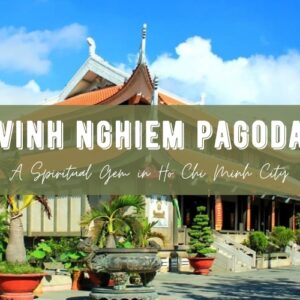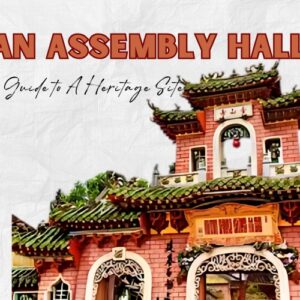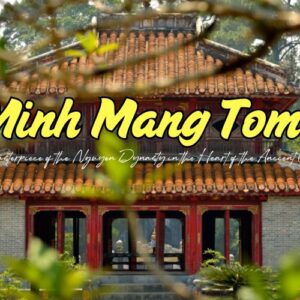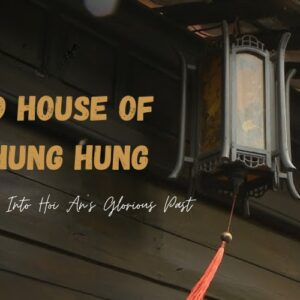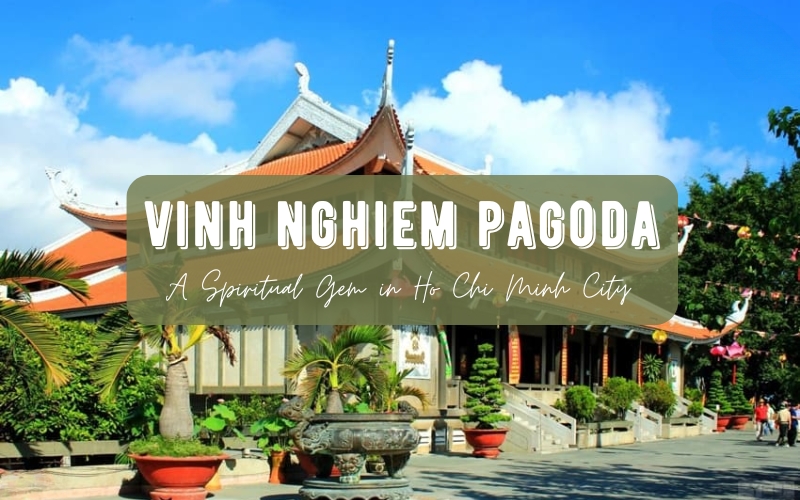
Located in the heart of Ho Chi Minh City, Vinh Nghiem Pagoda is a peaceful haven amidst the chaos of the city. Renowned for its impressive architecture, peaceful atmosphere, and cultural significance, this iconic Buddhist temple is a must-see for visitors looking to connect with Vietnam’s spiritual heritage. This guide will help you plan your visit and ensure you make the most of your time at this historic site.
General information about Vinh Nghiem Pagoda
Address: 339 Nam Ky Khoi Nghia, Ward 7, District 3, Ho Chi Minh City
Opening hours: 6 AM – 7 PM (Monday – Saturday), 6 AM – 11 PM (Sunday)
Entrance fee: free
Vinh Nghiem Pagoda is a very famous Northern Buddhist temple (Mahayana sect) in Ho Chi Minh City, built according to the prototype of the ancient temple of the same name in Bac Giang. Vinh Nghiem Pagoda was built in 1964 and completed in 1971. The temple is more than 6,000 m2 wide, providing a spacious, comfortable space for anyone looking for peace and relaxation in the heart of bustling Saigon. The temple is completed with beautiful architecture, a harmony between tradition and modernity. Curved tiled roofs, red brick walls, mother-of-pearl inlaid wooden doors, Buddha statues, and sophisticated carvings are the highlights of the temple.
Vinh Nghiem Pagoda is not only the most beautiful and largest pagoda in Ho Chi Minh City but also an important Buddhist center of the whole country. This is the place to train generations of monks and nuns, organize cultural, educational, and charitable activities. The pagoda is also a place that attracts domestic and foreign tourists to admire the architecture, learn about Buddhism, and pray for peace. It can be said that this is a spiritual tourist destination not to be missed when you come to Saigon.
Vinh Nghiem Pagoda is considered one of the special pagodas in Saigon, a peaceful space among modern high-rise buildings. Every holiday, Tet, or even on normal days, Vinh Nghiem Pagoda is still filled with incense and lights from pilgrims, tourists, as well as Buddhists visiting the pagoda.
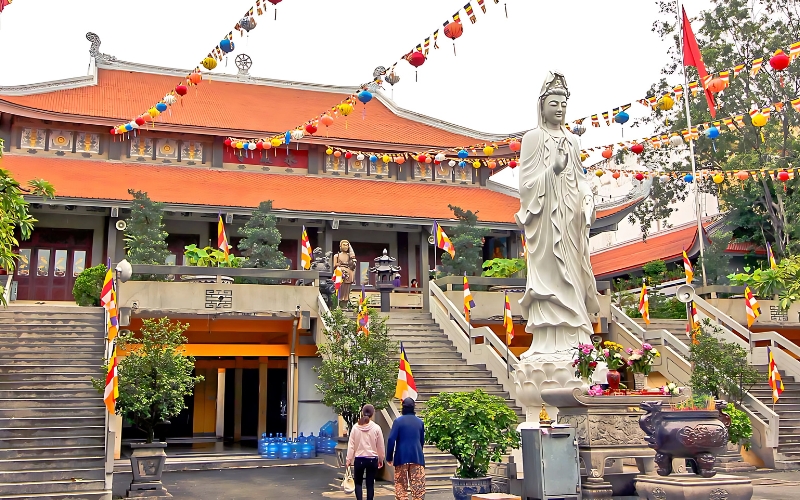
Vinh Nghiem Pagoda
>>> Let’s embark on our Ho Chi Minh City tours, an exciting gateway to explore the dynamic cityscape, historic landmarks, and cultural treasures that make Ho Chi Minh City a must-visit destination.
History of Vinh Nghiem Pagoda
After making a pilgrimage from the north to the south to spread Buddhism, two monks, Thich Tam Giac and Thich Thanh Kiem, built Vinh Nghiem Pagoda in Saigon as a place of meditation for Buddhists in the South. The pagoda was built according to the prototype of Vinh Nghiem Pagoda in Bac Giang (Duc La Pagoda), which was the Buddhist center of the Truc Lam Zen sect and was established during the reign of King Ly Thai To.
Vinh Nghiem Pagoda in Saigon was designed by architect Nguyen Ba Lang, who is also associated with a series of impressive cultural and spiritual works in Vietnam such as: One Pillar Pagoda, Ngoc Son Temple and The Huc Bridge, … In 1964, people had to move 40,000m3 of soil from Bien Hoa Highway to level the low-lying land next to Thi Nghe Canal to make a flat surface for building Vinh Nghiem Pagoda.
In 1971, Vinh Nghiem Pagoda completed the basic items, including the Central building, and Quan The Am Tower. Later, the pagoda successively built other structures such as: Xa Loi Cong Dong Tower, Vinh Nghiem Tower, Phuong Truong Duong, Khach Duong,… In particular, Vinh Nghiem Pagoda also received the great bell of Peace donated by Entsu-in Temple, belonging to the Japanese Buddhist Sangha before 1975, to pray for Vietnam to soon achieve peace.
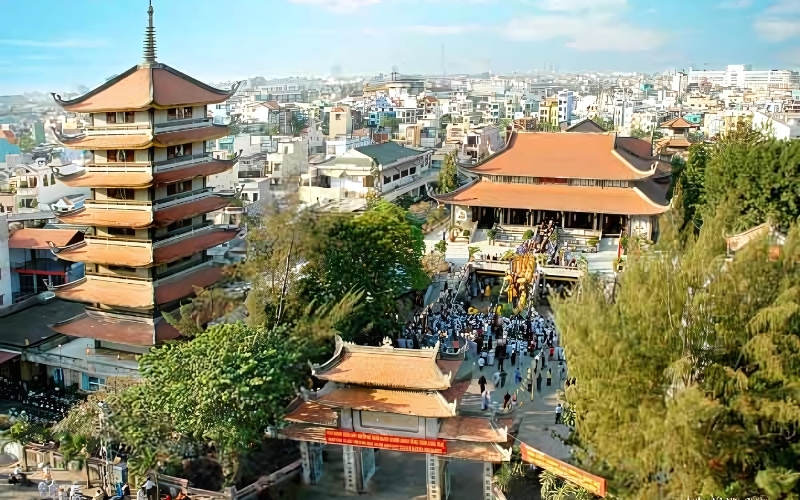
The pagoda was built according to the prototype of Vinh Nghiem Pagoda in Bac Giang
How to get to Vinh Nghiem Pagoda
Vinh Nghiem Pagoda is located near the city center and the road is quite convenient. Therefore, you can choose to travel by car or motorbike to be more proactive about time and route, as well as have the opportunity to see the streets of Saigon.
- Taking a taxi or using ride-hailing apps such as Grab, Xanh SM, Be is the most convenient way to get to Vinh Nghiem Pagoda. You just need to simply enter the name of the pagoda on the app and the driver will take you there. The cost for each trip ranges from 50,000 VND to 150,000 VND, equivalent to 2 to 6 USD, depending on your starting location.
- In addition, in a modern city like Saigon, taking the bus is also a good and more economical choice. Look for suitable bus routes, you can find stops near the pagoda such as Nguyen Van Troi Intersection, Phu Nhuan Market, or Nam Ky Khoi Nghia Street. The fare is very cheap, about 10,000 VND or less. pay attention to the bus route or ask the driver and bus conductor to remind you to avoid getting lost.
- If you want to explore on your own and have a more private experience, rent a motorbike and explore the city. This is a flexible and free way to travel, you can explore other attractions nearby after visiting the temple.
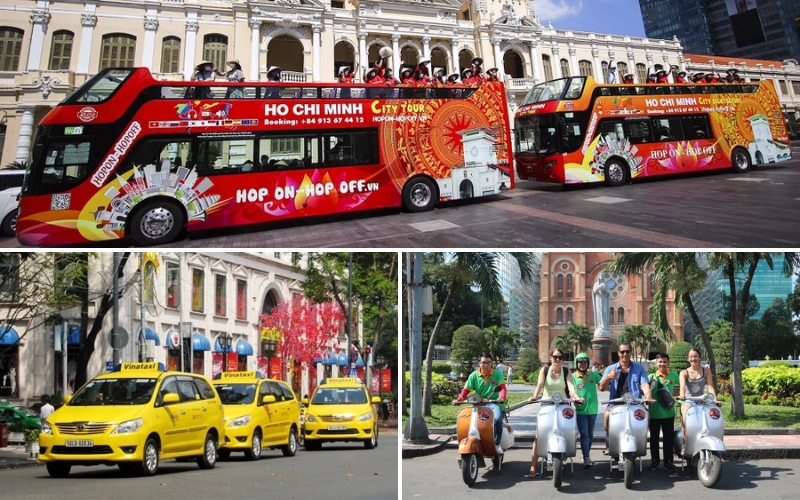
You can get to Vinh Nghiem Pagoda by many ways
What to see at Vinh Nghiem Pagoda
Tam Quan
The Tam Quan gate of Vinh Nghiem Pagoda is a symbol of the solemnity and majesty of the largest pagoda in Ho Chi Minh City. It is quite massive, built in the traditional Vietnamese architectural style with a curved red tiled roof, mother-of-pearl inlaid wooden doors and sophisticated carvings. The gate is 12 meters high, 16 meters wide and 5 meters deep, including three doors. On both sides of the temple gate are two delicately carved parallel sentences, above which is the golden inscription “Chua Vinh Nghiem”. From the Tam Quan gate, you can see the large temple yard, and the stupa on the left.
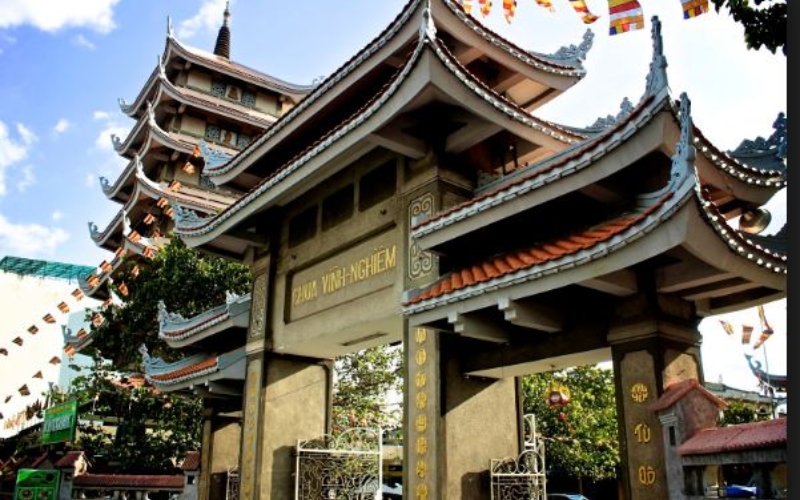
Tam Quan gate of Vinh Nghiem Pagoda
Central building
After passing the massive statue of Bodhisattva Avalokitesvara in the middle of the yard, you will enter the central building, a solid structure with 3 wide staircases leading to the rooftop, the Buddha hall and the Avalokitesvara Tower. The terrace is about 10m wide, on the right side is the bell tower, where the big bell is hung, donated by Buddhists in 1975 to pray for peace in Vietnam soon.
The Buddha Hall has the architecture of the letter “Cong” with curved roof corners in the style of Northern pagodas. In the middle of the roof of the Buddha Hall is the Dharma wheel and sacred animals in the corners of the roof. The Buddha Hall is divided into three spaces: Bai Dien, Ban Dien, and Dia Tang Duong, where the altars of Buddha and Bodhisattvas are placed. In addition, there are paintings of Arhats and Kim Cang statues.
In addition, the central building also has a ground floor, part of which is located under the terrace, part of which is located under the Buddha Hall. This space is used as a lecture hall, library, and ancestral shrine.
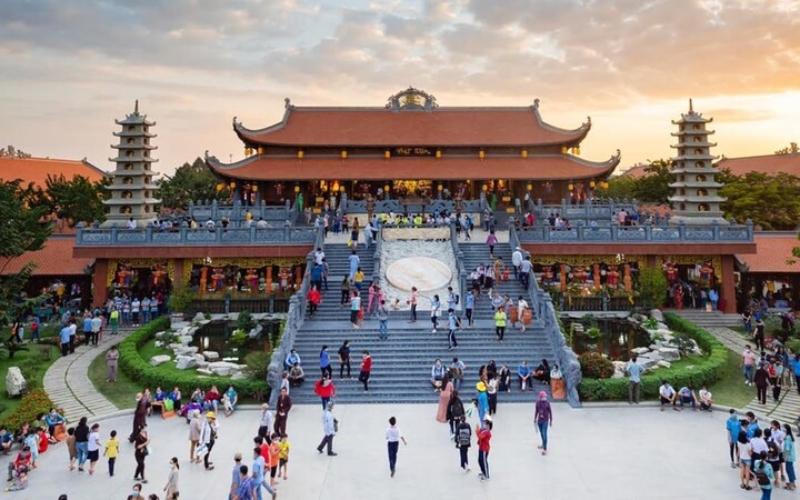
The central building
Quan The Am Tower
Quan The Am Tower is a 7-storey stupa located to the left of the Buddha Hall and is the symbol of Vinh Nghiem Pagoda in Saigon. The tower is shaped like a lotus flower and is made of concrete and granite. The top of the tower has 9 wheels and round blocks symbolizing the dragon carriage and the pearl. The tower also preserves cultural and historical values, including many paintings, books and publications related to Vietnamese Buddhism and other countries in the world. With a height of 40m and elaborate architecture, Quan The Am Tower is considered one of the most massive stupas in Vietnam.
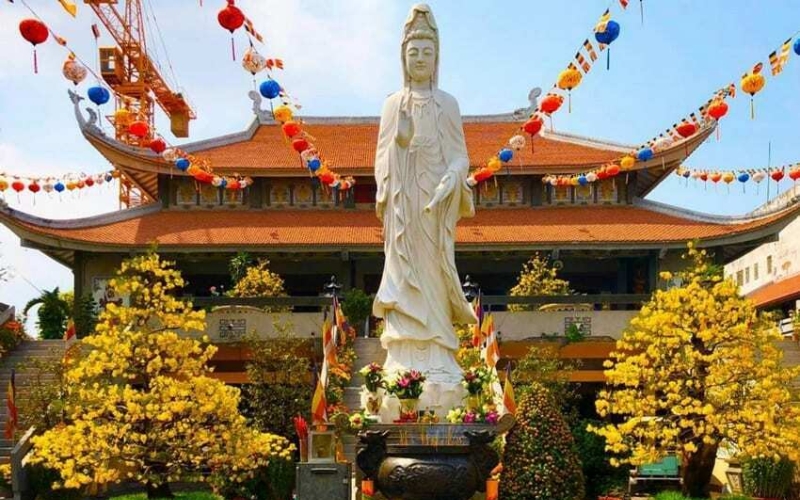
Quan The Am Tower
Xa Loi Cong Dong Tower
This is a unique and meaningful work of Vinh Nghiem Pagoda. Xa Loi Cong Dong Tower was built in 1982 and completed in 1984, serving as a place to place the remains of more than 20,000 Buddhists. The tower has 4 floors, 25m high, and is built behind the Buddha Hall. The architecture of the tower is in a modern style with red tiled roofs and round windows. Each floor has a separate worship room, with an altar, Buddha statues and religious items.
This is not only the resting place of the deceased but also a place for relatives and Buddhists to come to pray, commemorate and show gratitude. The tower is a symbol of the longevity and solemnity of Buddhism, preserving and spreading the spirit of Buddhism to future generations.
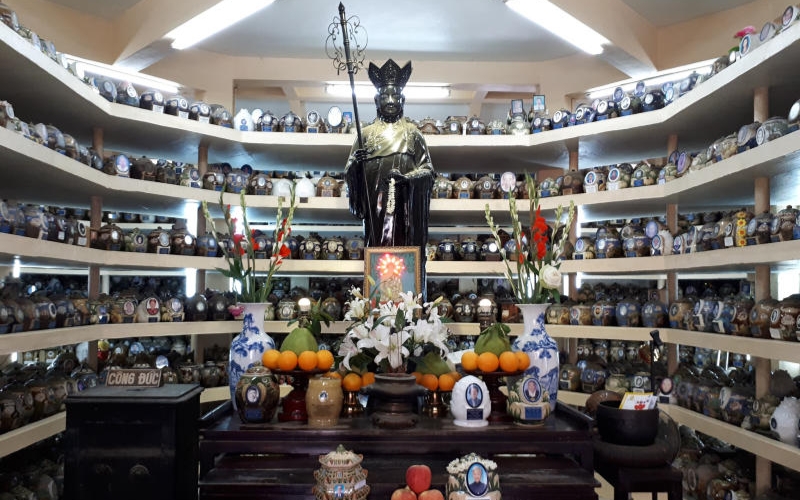
Inside Xa Loi Cong Dong Tower
Vinh Nghiem Tower
From the main gate, you will see Vinh Nghiem Tower on the right, shaped like a candle. This structure was inaugurated in 2003, 14m high, and made entirely of stone. The tower is built with three floors, each floor has a large hall for worship and meditation. On the roof of the tower is a large crystal ball, symbolizing the clarity and understanding of Buddhism. Vinh Nghiem Tower was built to commemorate two monks who built the temple and is considered the first stone tower in the South and also the tallest stone tower in Vietnam to date.
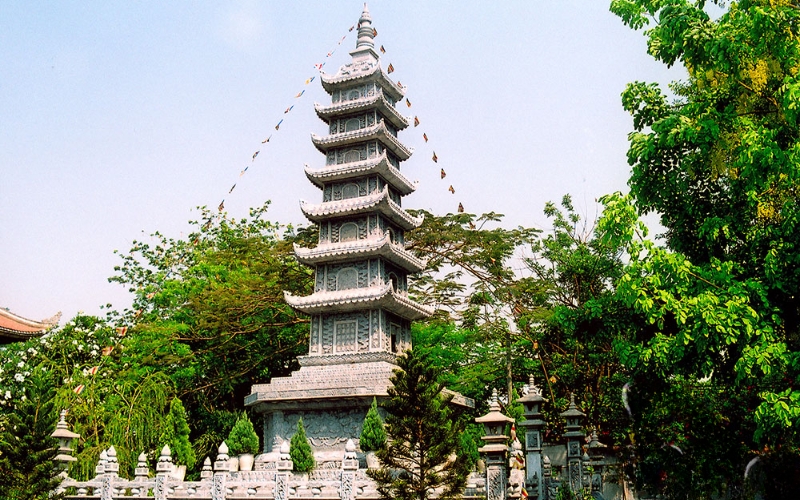
Vinh Nghiem Tower, the tallest stone tower in Vietnam
Notes when visiting Vinh Nghiem Pagoda
Here are some tips to make your trip to Vinh Nghiem Pagoda perfect:
- As with other sacred places, you should adhere to the rules of dress, communication and behavior when visiting the temple. When entering the temple, you need to wear long, closed-neck clothes and walk softly. Avoid wearing short-sleeved shirts, tank tops, shorts and short skirts. Or you can wear clothes specifically for going to the temple to show your respect to the Buddha. You should also wear comfortable but still polite shoes that can be easily removed when entering the worship areas.
- When passing through the three-door gate, you should enter through the right door (gia quan) and exit through the left door (khong quan). The middle door (trung quan) is only for high monks and emperors.
- When entering the Buddha hall or the stupas, do not forget to bow and greet before entering. Absolutely do not point at Buddha statues or sacred objects. You should also not take photos or videos in these areas to avoid disturbing others.
- Consider buying vegetarian offerings, not meat offerings. You should also limit the burning of votive paper or other items to keep the air fresh and safe for the environment here.
- Be aware of maintaining general hygiene and follow the temple’s signs. You should also maintain a humble and respectful attitude towards monks and Buddhists. Limit noise or affect the tranquility of Vinh Nghiem Pagoda.
- One of the things that makes Vinh Nghiem Pagoda Saigon known to many people is the volunteer activities as well as social work, helping the community that are regularly organized here. If you have time, you can participate in charity activities at the pagoda to gain more experience, contribute to helping people in difficult circumstances, and make your trip to Saigon more meaningful than ever.
The architectural beauty and cultural and historical values that Vinh Nghiem Pagoda possesses are what hold the footsteps of many people when visiting this unique place. If you have the opportunity to visit Saigon, you should definitely visit Vinh Nghiem Pagoda to learn more about the beliefs and people here. The peace in the middle of the bustling city will help you forget the fatigue of daily life.
Read more:

